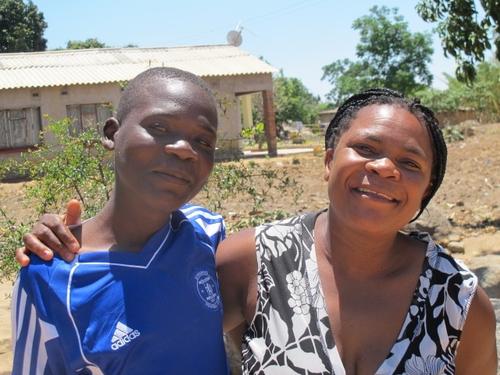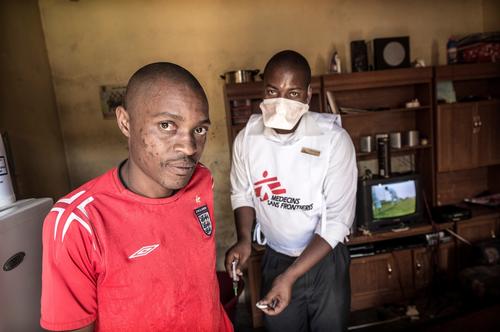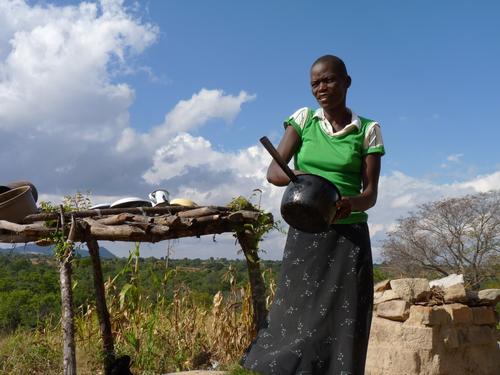As a teenager Gibson Chijaka from Zimbabwe was diagnosed with drug-resistant tuberculosis (DR-TB). Cases are on the rise in southern Africa attributed to the high HIV prevalence and TB’s highly contagious nature. While early detection and prompt treatment of confirmed cases is key to DR-TB prevention, treatment and control, this form of TB is very difficult to treat with poor outcomes compared to drug sensitive TB. It takes a long time and many pills to be cured, but Gibson went through it all.
When the 14 year old orphan was diagnosed with drug-resistant tuberculosis in 2012, his guardians thought this was his death knell as many frightening stories had been told about the epidemic. Due to the nature of the treatment, some prophets of doom had already sealed the teen’s fate. It was now only a matter of time. But Gibson Chijaka, who lives in Epworth on the periphery of Harare, has just been declared cured of the dreaded DR-TB, after receiving injections every day for eight months and taking dozens of nauseating tablets daily for the last two years.
“I am so happy and cannot hold back my joy. The last two years have been the most painful in my life. First being diagnosed with DR-TB at the tender age of 14 was not easy for me. People would ask what type of TB I had that needs injections every day for eight months. Some would even ask what type of TB is it thatneeds 18 tablets every day for two years. This is in addition to the anti-retroviral drugs I am taking”, said an elated Gibson, who has never known his mother as she passed away when he was still an infant.
Due to lack of information, there is still a lot of stigma surrounding DR-TB in many communities across Zimbabwe. However, the medication makes it even worse – it’s discouraging. So being diagnosed with DR-TB was a double tragedy for Gibson as he had to deal with the stigma and the agonising medication. This is one reason why the contagious DR-TB continues to spread as many cases are going undetected due to fear of stigma and treatment.
“My daughter who was looking after Gibson was evicted from three different houses that she was renting, as the other tenants felt vulnerable to the communicable DR-TB. I had to summon all my courage to defy negative talk and took him in as he had nowhere to stay. But then, deep inside, I was not sure if it was a good decision. I was afraid that he may spread TB to the other family members although I did not let him know this. As a result, we were discriminated against in the community,” said Margaret Kadzere, Gibson’s grandmother, who lives with 21 other family members at her house.
She and other family members confessed that their worries dissipated somewhat after health education sessions with Médecins Sans Frontières (MSF) health staff at Domboramwari Poly Clinic where Gibson was receiving treatment. Gibson’s relatives never thought that he would last the two year treatment. Their worst fear was that he would never be cured of this DR-TB, as he had many TB treatments in the past without success.
“We had given up on Gibson and he was bed ridden. At one point we even wondered if the MSF people were sincere in trying to save his life or if they just wanted to experiment with their drugs as there seemed to be no life in him. But the health lessons they gave us reshaped our thinking and we turned this fear into courage, as we were then determined to prove that these drugs really work despite the stigma,” said Linnet Kadzere, Gibson’s sister-in-law.
Gibson is one of the many patients who have been diagnosed, treated and cured of DR-TB in MSF projects across Zimbabwe. Just last year, 63 DR-TB patients were cared for in MSF projects across Zimbabwe.
In the Epworth project, the DR-TB programme has so far seen eight patients treated and cured since its inception in August 2010, with the first patient having started treatment on 28 December 2010. The programme aims at implementing a community-based DR-TB programme while supporting the National TB programme in DR-TB management.
“HIV weakens people’s immune system and the virus opens the door to opportunistic infections like TB. DR-TB is an epidemic that requires a new strategy, new tools, new drugs and new public health approaches. The positive thing is that we are now proactively looking for DR-TB hence the increase in the number of cases we are detecting,” says Dr Dorly Legrand, who is responsible for the Epworth project TB programme.
A volunteer community health worker, Violet Bvute, who visited Gibson on a daily basis to ensure that he did not stop taking his medication, feels that the duration of treatment discourages people from being tested for DR-TB.
“Gibson had a strong will to live. Despite his complaints about the drugs' side effects, he never stopped taking his tablets in two years. I think the pill burden is one of the factors that demotivates DR-TB patients”, said Bvute.
The treatment approach for DR-TB is slightly different in a rural set up. For instance in Tsholotsho district, MSF employs a patient centred decentralised community based model of care. After confirmation of diagnosis, a home visit is made for each case to aid in contact tracing, infection prevention and control assessment, determination of distance to and from the nearest health facility, identification of direct observed treatment support and to assess living conditions.
National protocol in Zimbabwe now recommends that every HIV patient with a suspect cough is screened for TB using the GeneXpert machine, a new rapid molecular test. The GeneXpert MTB/RIF not only speeds up diagnosis but it also screens for drug-resistant TB and improves TB detection among people who have falsely tested negative through sputum smear. Currently, there is an ongoing prevalence study by health authorities to appreciate the burden of DR-TB in Zimbabwe. The growing use of a new tool for rapidly diagnosing MDR-TB is helping to identify more and more patients.
Today, 16 year old Gibson has won the battle against DR-TB but he has lost two years of education, as the schedule for his medication clashed with the school timetable.
“I am grateful that the drugs have kept me alive, but it was like going through hell for me so that I could enjoy this life. I don’t think it has to be so painful for someone to be cured of DR-TB. If only I had an opportunity to talk to those who make these drugs, my appeal would be please can’t you just combine all these 18 tablets I was taking every day into one. And why not make it powerful so that I don’t have to endure two years taking them every day? The shorter period the better. If the treatment period was shorter, maybe I would have not dropped out of school for two years,” said Gibson.
MSF has been working in Zimbabwe since 2000. Gaps in treatment for HIV/AIDS and tuberculosis (TB), including drug-resistant TB (DR-TB), remain. The needs of children and teenagers are particularly overlooked. In 2013, 3,200 patients were under treatment for TB, of which 63 for MDR-TB.






